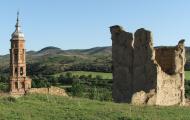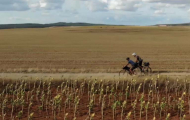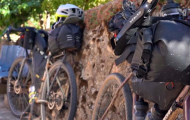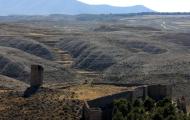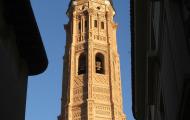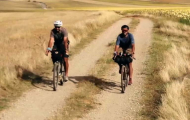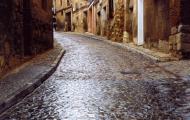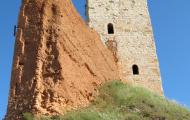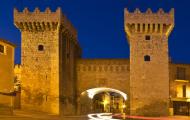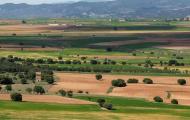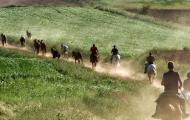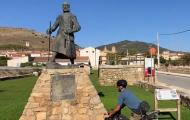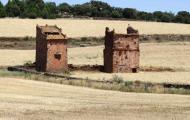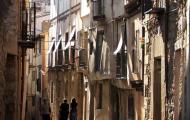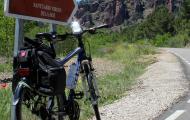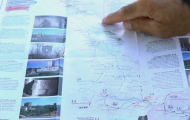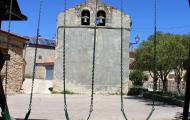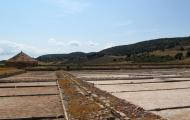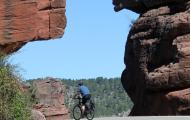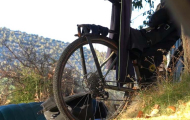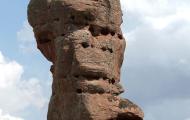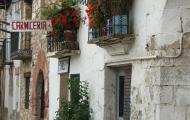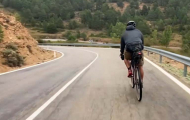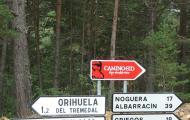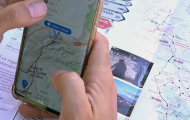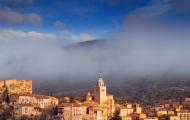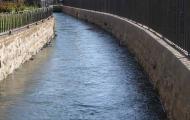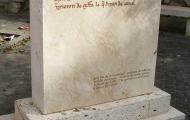The Three Taifas by gravel bike
ZARAGOZA - TERUEL - GUADALAJARA
The Three Taifas route by gravel bike. Travel through the lands of the old petty Kingdoms of Zaragoza, Toledo and Albarracín.
330 kilometres of wild Nature, History, art and Good Cycling. You will travel back in time through the territories of the Islamic principalities of Zaragoza, Toledo and Albarracín. Impressive landscapes and unforgettable villages! Follow el Cid on his route through the Three Taifas.
- Route: From Calatayud (Zaragoza) to Teruel.
- Provinces: Zaragoza, Guadalajara, Teruel.
- Kilometres: 333 km approx.
- Recommended days: 4 days (83 km / day approx.)

| TECHNICAL DATA | ||
| Distance: 333 km | Cumulative ascent: 4,960 m | Physical difficulty: Medium |
| Estimated time: 4/5 days | Accumulated descent: 4,580 m | Technical difficulty: Low |
| This is a route designed for gravel bikes and is 100% cyclable, following rural roads with a good surface, comfortable tracks and lonely roads. The route offers no significant gradients except for the climbs in stages 3 and 4 through the exceptional landscapes of the Alto Tajo and Sierra de Albarracín. | ||
Information you can download on this page
- PDF gravel guide (contains detailed maps)
- The list of accommodation.
- The list of tourist offices.
- The tourist brochure ( which you can request at any of the tourist offices along the route).
- Guides on: the hikingroute , the castles, and the nature of the Camino del Cid as it passes through the province of Zaragoza, published by the Diputación Provincial de Zaragoza.
- Los tracks de la ruta en formato gpx, kmz y trk.
Remember that in the Tourist Offices of the Camino del Cid you can get more information about each route free of charge: including brochures and the safe-conduct.
Download our travel app free of charge
We recommend you download our mobile travel app, available on iOS and Android. The app contains all our routes, you'll never get lost and you'll find information on 4,500 geo-referenced points (Cidian enclaves, places to see, accommodation, pass stamping points, etc.).
The app is free, updated daily and does not require registration. It also works in environments without coverage, so during installation and when you first turn it on, depending on your connection, it may take a few minutes to get it up and running, so be patient, it's worth it!

Plot: through the lands of the Three Petty Islamic Kingdoms
El Cid fought his first great literary battle (i.e. according to the Cantar) against a Muslim army at Alcocer, today an uninhabited village near Ateca. The victory fell on the side of El Cid's army and Rodrigo himself arrived, chasing one of the generals defeated in the battle, to the gates of Calatayud, 15 km away, and this is where our route begins.
This victory and the organisation and autonomy of his increasingly numerous army allowed him to move smoothly between the borders of the different Muslim kingdoms. Three very different taifas - Toledo, Saragossa and Albarracín - served as the stage for the passage of the literary Cid and his people. According to the verses of the Cantar, the victory of Alcocer gave el Cid free passage to impose his law on the different roads and towns of these taifas.
There are four fundamental milestones in the Cantar in this section: El Poyo del Cid, in Teruel, where el Cid reinforced a Roman fortification to turn it into his centre of operations in the territories of Teruel and Zaragoza; Molina de Aragón, in Guadalajara, a lordship governed by Avengalbón, a Muslim ally of el Cid who will serve him faithfully and protect Rodrigo's daughters; Albarracín, in Teruel, a place of passage for el Cid's hosts in their transit between Castile and the Mediterranean, and Cella, a town in Teruel where, according to the Cantar, el Cid decided to gather all those men who wanted to accompany him to conquer the city of Valencia.
The journey
You have before you 300 intense kilometres of landscapes, history, art and adventure, crossing old and rugged territories that formed part of three Muslim or Taifa kingdoms. A physically demanding route - the second part, from Molina de Aragón onwards, runs through mountainous areas - but fascinating in its route, whose landmarks include four important medieval walled complexes: Calatayud, Daroca, Molina de Aragón and Albarracín.
Calatayud, due to its length and antiquity, is one of the most important Islamic walled enclosures in Spain. The Muslim heritage is also very palpable in its Mudejar heritage, whose outstanding example is the Collegiate Church of Santa María La Mayor, declared, along with other examples of this art in Aragon, a World Heritage Site.
The second major landmark on our route is Daroca, once a very important Islamic fortress in the Jiloca valley, one of the passages for ideas, goods and armies since ancient times, as it linked the Meseta, the Ebro valley and the Levante. Daroca has an important and varied artistic heritage - with good examples of Romanesque architecture - in keeping with the city's rich history. At sunset its walls take on a peculiar golden hue.
Molina de Aragón is the third epicentre of the route: a monumental city with its castle as a symbol, perhaps the tallest of all those found on the Camino del Cid.
From Molina the landscape changes dramatically and we plunge into one of the wildest areas of the whole itinerary along 125 km of regional and autonomous roads, in small sections with steep slopes that will test your strength, where you are likely to come across as many roe deer as cars.
To Albarracín we will cross the Barranco de la Hoz ravine and five natural areas: the Alto Tajo Natural Park, Montes de Picaza, Tremedales de Orihuela, the Sabinar de Monterde de Albarracín and the Pinares de Ródeno: canyons and river gorges, rocky raptors, mixed forests of holm oak, juniper and laricio pine -with predominance of the latter- , tremedales, mountain goats and all kinds of deer.
The whole area is also an impressive open-air geological museum where you can see all kinds of faults, folds, rivers of stone, dropstones and all kinds of erosive phenomena, some of them very striking, such as the towers of Chequilla. Crossing these landscapes we arrive at Albarracín, one of the most beautiful villages in Spain.
Albarracín is the fourth great walled complex of the route, it was the capital of the small but important taifa of the Banu Razin and here the historical Cid was on the point of dying during a scuffle. From Albarracín, after a well-deserved rest, we head for Cella.
On this last route we can visit one of the most important works of Roman hydraulics in this area, preserved by the Arabs: the aqueduct that links Albarracín and Cella, part of which is excavated in the rock and which the traveller can walk along some of its sections. One last surprise awaits us in Cella: its artesian well, one of the largest in Europe.
Cella must have been a "hot" border town in the 12th century, where mercenaries abounded, and it is the place chosen by the author of the Cantar for el Cid to wait for all those who wanted to accompany him in the conquest of Valencia. The route ends in Teruel, a communications hub and service centre.
Culinary delights
Gastronomy in these areas has one common denominator, especially in the mountains: heavy stews and game, ranging from stewed beans with game to pickled partridges, including vegetable stews. However, the unquestionable king of the table is ternasco (young lamb), which shares its throne with stewed kid goat in Molina de Aragón.
Don't leave Calatayud without trying its wonderful chickpeas with conger eel or fardeles and don't leave the province of Teruel without trying its famous ham, with Calamocha as the most important place in the local "ham world".
Fish dishes include traditional cod and trout. Besides the delicious peaches in wine, all along the route you will find different deserts of Mudejar origin, gastronomic evidence of its Islamic past: Daroca is famous for this type of confectionery and you can try the Mudejar trenzas or almojábanas, the most famous of which are to be found in Albarracín, which is also well known for its excellent cheeses.
Singular roads
The term ‘Singular Road' on the Way of El Cid is used for the sections of road that are of particular importance for cycling tourists or because of the countryside, history or artistic heritage. This route has the following Singular Roads:
- GU-958 road between Ventosa and Torete (10 km). Guadalajara
This simple provincial road runs next to the River Gallo through peaceful countryside in the heart of the Natural Reserve of the Upper Tagus. It is a very pleasant route for cycling tourists, setting off from Molina de Aragón. Although it is narrow and has patches on the surface, it has hardly any traffic mid week and is flat with a slight downhill. On the route, travellers can stop off at the Gothic-Renaissance Church of La Virgen de La Hoz, guarded by high, interesting crags that stand as the result of erosion, which sometimes creates strange 'hallucinations' in stone.
Signposting
We have designed a route that is 100% suitable for gravel bikes, following rural roads with a good surface, comfortable tracks, asphalted roads and lonely roads. There is no signposting of the gravel route as such, but as it largely coincides with the MTB and hiking routes, you should pay attention to the signposting on these sections.
We recommend you download the track or the App, and before starting your journey, checkthe Route Alerts box in our map viewer, which shows you the most important incidents that you may encounter on the route: high vegetation, interrupted crossings, road works, fallen or missing signs and any other obstacle that you need to be warned of.
Climatology
The more than 1,000 metres of difference in altitude between Calatayud and Bronchales condition the climatology of the route, with a transition from a Mediterranean climate to a more continentalised one, marked by very cold winters. The triangle formed by the towns of Calamocha, Molina de Aragón and Albarracín is considered one of the coldest in Spain. Precipitation is generally not very high and is highly conditioned by orientation and altitude, with marked contrasts between nearby points. Precipitation in the form of snow is common in the winter months, although only in some parts of the Alto Tajo and Sierra del Tremedal can it be significant.
Tips and recommendations
- Length of the stages: ideally, each person should define their stages according to their personal strengths and interests: some people prefer the sporting aspect, the cultural dimension of the trip or the simple sensory pleasure of enjoying landscapes and situations at a leisurely pace. The stages we propose are a mixture of all of these, and are designed so that the average cyclist in stable weather conditions can enjoy the itinerary at their leisure.
- Groceries and spare parts. One of the great attractions of the Camino del Cid is that it runs mostly through very attractive but sparsely populated places: many villages are very small and have no grocery shops. It is very important that, unless you have planned to eat in a bar or restaurant, you carry some food in your saddlebags (sandwiches, nuts, energy bars...) that can help you out of a tight spot. Don't forget to take water with you. Most of the villages have fountains: don't forget to fill up your water tank before leaving them. And the same goes for bike parts: don't forget to take a repair kit with you on the road: the more complete it is, the more relaxed you'll be. If you have a mobile phone, don't forget to leave with a full battery.
- Book your accommodation in advance. Book your accommodation at the end of the stage in advance, and if you change the end of the stage, check that there is accommodation or a reception point at that point.
- Don't forget to wear a helmet: it is legally compulsory for adults on all road sections outside the city and for children under 16 years of age it is compulsory at all times.
- Get your safe-conduct. The safe-conduct is a personalised "passport" that you can stamp in many places along the Camino del Cid.
- Your literary guide. It seems like an unnecessary burden, but for many it is an essential guide: don't forget to bring a Cantar de mío Cid; you will be able to recreate some of its passages in situ. It is preferable that you use a modernised edition!
How to get there… and get back
To know the different transports to Calatayud, click on the information of the municipality.
To find out about transport in Cella, click on the information about the municipality. Some travellers extend their journey one more stage to Teruel, 27 km away, an important transport hub. To find out about the different means of transport in Teruel, click on the information about the municipality.
Rev. CAM: 20.04.25


